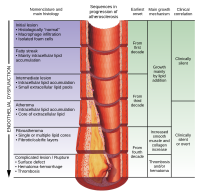
Photo from wikipedia
Peripheral artery disease is an atherosclerotic disease of arterial vessels that mostly affects arteries of lower extremities. Effort induced cycles of ischemia and reperfusion lead to increased reactive oxygen species… Click to show full abstract
Peripheral artery disease is an atherosclerotic disease of arterial vessels that mostly affects arteries of lower extremities. Effort induced cycles of ischemia and reperfusion lead to increased reactive oxygen species production by mitochondria. Therefore, the pathophysiology of peripheral artery disease is a consequence of metabolic myopathy, and oxidative stress is the putative major operating mechanism behind the structural and metabolic changes that occur in muscle. In this review, we discuss the evidence for oxidative damage in peripheral artery disease and discuss management strategies related to antioxidant supplementation. We also highlight the major pathways governing oxidative stress in the disease and discuss their implications in disease progression. Potential therapeutic targets and diagnostic methods related to these mechanisms are explored, with an emphasis on the Nrf2 pathway.
Journal Title: Physiological Reports
Year Published: 2018
Link to full text (if available)
Share on Social Media: Sign Up to like & get
recommendations!